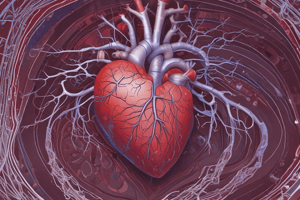Podcast
Questions and Answers
What is the primary etiological factor in the development of coronary artery disease?
What is the primary etiological factor in the development of coronary artery disease?
- Hypertension
- Smoking
- Genetics
- Hyperlipidemia (correct)
A patient presents with chronic stable angina. What is the most likely clinical manifestation?
A patient presents with chronic stable angina. What is the most likely clinical manifestation?
- Chest pain with exertion (correct)
- Chest pain at rest
- Pain radiating to the left arm
- Shortness of breath
What is the primary difference between unstable angina and NSTEMI?
What is the primary difference between unstable angina and NSTEMI?
- Presence of heart failure symptoms
- Duration of chest pain
- Presence of EKG changes
- Presence of troponin elevation (correct)
What is the HEART score category for a patient with a score of 7?
What is the HEART score category for a patient with a score of 7?
A patient presents with acute chest pain and EKG shows ST segment elevation in leads II, III, and aVF. What is the most likely diagnosis?
A patient presents with acute chest pain and EKG shows ST segment elevation in leads II, III, and aVF. What is the most likely diagnosis?
What is the primary goal for a patient with ACS who is sent to the cath lab?
What is the primary goal for a patient with ACS who is sent to the cath lab?
What is the most important assessment to perform on a patient with ACS?
What is the most important assessment to perform on a patient with ACS?
What is the primary complication of STEMI?
What is the primary complication of STEMI?
Flashcards are hidden until you start studying
Study Notes
Etiology and Pathophysiology of Coronary Artery Disease (CAD)
- CAD leads to reduced blood flow and oxygen to the heart, potentially resulting in Acute Coronary Syndrome (ACS).
- Risk factors include hypertension, hyperlipidemia, diabetes, smoking, and a sedentary lifestyle.
- Plaque rupture in atherosclerosis provokes thrombus formation, obstructing coronary arteries and contributing to angina or myocardial infarction.
Angina Types
- Chronic Stable Angina: Triggered by exertion or stress, resolves with rest or nitroglycerin; characterized by predictable frequency.
- Prinzmetal’s Angina: Caused by coronary artery spasms, often occurring at rest; typically transient and triggered by stress or cold.
- Unstable Angina: Occurs at rest, unpredictable, prolonged, and exacerbated by physical or emotional stress; indicates significant coronary artery obstruction and risk for myocardial infarction.
Clinical Manifestations of Angina
- Typical complaints include chest discomfort, pressure, or pain; may radiate to the arms, neck, jaw, or back.
- Patients with unstable angina may present with severe, sudden onset of symptoms distinguishing it from chronic stable angina.
- Health disparities exist: minority communities may experience delayed diagnosis and access to care, leading to worse outcomes.
Differentiating Unstable Angina, NSTEMI, and STEMI
- Unstable Angina: No cardiac enzyme elevation, ST-segment depression or T-wave inversion on EKG; transient ischemia.
- NSTEMI: Cardiac enzyme elevation (e.g., troponin), ST-segment depression or T-wave inversion on EKG; signifies partial occlusion.
- STEMI: Elevated ST segments on EKG indicate complete occlusion of a coronary artery; cardiac enzyme elevation essential for diagnosis.
Diagnostic Tests and Labs
- Initial EKG changes help differentiate between unstable angina, NSTEMI, and STEMI.
- Cardiac biomarkers (troponins, CK-MB) are critical; serial lab tests may indicate continuous damage in NSTEMI and STEMI.
Nursing Management and Acute Chest Pain
- Monitor vital signs, administer oxygen if hypoxic, and provide aspirin and nitroglycerin.
- EKG should be done immediately for initial assessment; assess pain characteristics and response to nitroglycerin.
- Provide patient education on lifestyle changes and medication adherence post-discharge.
HEART Score
- Categories: History, EKG, Age, Risk factors, and Troponin levels.
- Utilized to evaluate risk of major adverse cardiac events; informs treatment decisions and discharge pathway.
Cath Lab and tPA Considerations
- Patients with high risk for myocardial infarction are prioritized for cath lab intervention; goal is within 90 minutes of arrival.
- tPA (thrombolytics) is indicated for STEMI patients if within the treatment window and no contraindications exist.
Follow-Up and Monitoring
- Post-MI follow-up should include assessing for complications, medication adherence, and lifestyle modifications.
- Evaluating treatment effectiveness through symptom relief and functional capacity improvement.
Complications of STEMI
- Potential complications include arrhythmias, heart failure, and cardiogenic shock.
- Physical exam may reveal abnormal heart sounds, signs of fluid overload, and vital sign instability.
Takotsubo Cardiomyopathy
- A stress-induced condition primarily affecting women, presenting with symptoms similar to myocardial infarction.
- HPI typically involves a recent emotional or physical stressor, dyspnea, and chest pain; heart function usually normalizes over time.
Hypertensive Crisis
- Causes include poorly controlled hypertension, medications, or adrenal causes.
- Clinical manifestations include severe headache, anxiety, chest pain, and altered mental status.
- Nursing management involves immediate BP reduction, assessment of end-organ damage, and continuous monitoring.
Treatment Goals
- Rapidly lower blood pressure to prevent complications while maintaining organ perfusion.
- Assess effectiveness by monitoring BP trends and resolving symptoms.
Studying That Suits You
Use AI to generate personalized quizzes and flashcards to suit your learning preferences.





